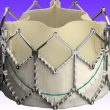Courtesy of Dr. Carlos Fava. The gold standard for failing aortic bioprosthesis has traditionally been surgery. However, since the first valve in valve (TAV-in-SAV) report in 2007, by Wenaweser, transcatheter valve implantation has emerged as a valid alternative. Even so, at present there is not enough scientific evidence in this regard. The present study analyzed...
MitraClip Procedure Can Be Performed without General Anesthesia
Courtesy of Dr. Carlos Fava. Avoiding general anesthesia in intervention procedures has the benefits of faster recovery and shorter hospitalization. This has been already analyzed in the context of TAVR, but not in MitraClip procedures. The present study analyzed 232 patients receiving the MitraClip. 76 of these procedures were done under general anesthesia (32.7%) and...
The SOURCE 3 Confirms the Good Outcomes of the SAPIEN 3 at One Year Followup
Transcatheter aortic valve replacement (TAVR) was developed as a strategy to treat non-surgical aortic stenosis, and was later expanded to elderly patients at intermediate risk, because of increased operator experience (overcoming the learning curve) and improved devices. The present study presents the one year outcomes of the SOURCE 3 trial, the multicenter European registry of the...
Excellent Outcomes for the First Sirolimus Eluting Balloon Tested on Instent Restesosis
Much has been done since studies on conventional balloon angioplasty for BMS instent restenosis showed over 40% new revascularization. Drug eluting stents, aimed at improving this problem, have never achieved 0% restenosis, which is why technologies such as paclitaxel coated balloons have been developed, with reasonable efficacy (8% to 10% reinterventions rate for BMS restenosis and 17% to 23%...
EnligHTN: treatment of refractory hypertension by catheterization
Lowering blood pressure with renal denervation has been demonstrated in previous studies but unfortunately there was not much data regarding the reduction of clinical events. This study will enroll patients between 40 and 55 years of age with resistant hypertension plus risk factors for major cardiovascular events. A five year follow-up has been planned. The...
Impact of kidney function on TAVI outcome
Original title: Impact of chronic kidney disease on the outcome of transcatheter aortic valve implantation: results from the FRANCE 2 Registry. Reference: Atsushi Oguri, et al. EuroIntervention 2015;10:e1-9 Globally, 13% of patients present kidney failure, which has been associated to a worse evolution not only of TAVI outcomes but also of other cardiovascular intervention outcomes. Most studies, including...
Contrast-induced nephropathy in the context of PCI, a lot more frequent in women
Original title: Female gender and contrast-induced nephropathy in primary percutaneous intervention for ST-segment elevatio myocardial infarction. Reference: Stefano Lucreziotti, et al. International Journal of Cardiology 2014;174:37-42 Primary PCI has been demonstrated beneficial. However, it is associated to greater contrast-induced nephropathy (CIN) with increased in hospital and long term morbidity and mortality. In addition, several reports have shown...
What is the contrast media dosing that predicts acute kidney injury after TAVI?
Original title: Renal Function-Based Contrast Dosing Predicts Acute Kidney Following Trancatheter Aortic Valve Implantation Reference: Masanori Yamamoto, et al. J Am Coll Cardiol Intv 2013;6:479–86. Acute kidney injury (AKI) presents in 10 to 30% of patients undergoing TAVI; it is associated to the increase of morbidity and mortality and it prolongues hospitalization. This study included 415 patients with...
Valve-in-Valve Implantation Is Possible
Original title: 5 Years Experience With Trancatheter Tranaspical Mitral Valve –in Valve Implantation for Bioprosthetic Valve Dysfunction Reference: Anson Cheung et al. J Am Coll Cardiol 2013;61:1759–66. Percutaneous valves development, first aortic and now mitral, has brought an opportunity to improve life quality and extend life for high risk non-surgical patients. 23 patients received transapical implantation in mitral...








